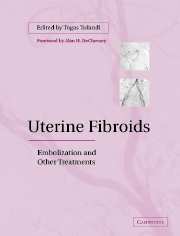Book contents
- Frontmatter
- Contents
- Contributors
- Preface
- Foreword
- 1 Uterine fibroids: epidemiology and an overview
- 2 Histopathology of uterine leiomyomas
- 3 Imaging of uterine leiomyomas
- 4 Abdominal myomectomy
- 5 Laparoscopic managment of uterine myoma
- 6 Hysteroscopic myomectomy
- 7 Myomas in pregnancy
- 8 Expectant and medical management of uterine fibroids
- 9 Hysterectomy for uterine fibroid
- 10 History of embolization of uterine myoma
- 11 Uterine artery embolization – vascular anatomic considerations and procedure techniques
- 12 Pain management during and after uterine artery embolization
- 13 Patient selection, indications and contraindications
- 14 Results of uterine artery embolization
- 15 Side effects and complications of embolization
- 16 Reproductive function after uterine artery embolization
- 17 Reasons and prevention of embolization failure
- 18 Future of embolization and other therapies from gynecologic perspectives
- 19 The future of fibroid embolotherapy: a radiological perspective
- Index
- Plate section
14 - Results of uterine artery embolization
Published online by Cambridge University Press: 10 November 2010
- Frontmatter
- Contents
- Contributors
- Preface
- Foreword
- 1 Uterine fibroids: epidemiology and an overview
- 2 Histopathology of uterine leiomyomas
- 3 Imaging of uterine leiomyomas
- 4 Abdominal myomectomy
- 5 Laparoscopic managment of uterine myoma
- 6 Hysteroscopic myomectomy
- 7 Myomas in pregnancy
- 8 Expectant and medical management of uterine fibroids
- 9 Hysterectomy for uterine fibroid
- 10 History of embolization of uterine myoma
- 11 Uterine artery embolization – vascular anatomic considerations and procedure techniques
- 12 Pain management during and after uterine artery embolization
- 13 Patient selection, indications and contraindications
- 14 Results of uterine artery embolization
- 15 Side effects and complications of embolization
- 16 Reproductive function after uterine artery embolization
- 17 Reasons and prevention of embolization failure
- 18 Future of embolization and other therapies from gynecologic perspectives
- 19 The future of fibroid embolotherapy: a radiological perspective
- Index
- Plate section
Summary
The first embolization for symptomatic myomata in Los Angeles was performed on November 24, 1994, at the University of California. The patients' bleeding following myomectomy was diminished using gelfoam delivered via arterial catheter. This began a collaboration between interventional radiologists and gynecologists for the treatment of symptomatic myomata using uterine artery embolization (UAE). During this study period, the technique of UAE has undergone some changes mainly due to the increasing experience of the interventional radiologists. Changes include the amount of devascularization, size of particles, and the introduction of new embolic materials.
Since the beginning of the procedure, our group has expanded to several interventional radiologists, and three types of facilities have been used to conduct the procedure. For the purpose of this review, we have evaluated whether the outcome of UAE is operator dependent or affected by the type and amount of particles used. We now have a five-year follow-up of women who have undergone the procedure. We have evaluated the long-term effects of embolization and the need for subsequent surgery. This chapter concentrates on analysis of results. We will briefly report our failures, and then reexamine them in Chapter 17.
Pre-embolization evaluation
Pre- and postmenopausal women are eligible if they have symptomatic uterine fibroid. We inform the potential patients about the lack of long-term follow up, and alternative treatment modalities.
- Type
- Chapter
- Information
- Uterine FibroidsEmbolization and other Treatments, pp. 101 - 110Publisher: Cambridge University PressPrint publication year: 2003

